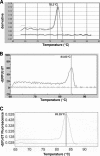The rtxA toxin gene of Kingella kingae: a pertinent target for molecular diagnosis of osteoarticular infections
- PMID: 21248099
- PMCID: PMC3122863
- DOI: 10.1128/JCM.01657-10
The rtxA toxin gene of Kingella kingae: a pertinent target for molecular diagnosis of osteoarticular infections
Abstract
Kingella kingae is an emerging osteoarticular pathogen in young children. Its isolation by traditional culture methods remains difficult, underscoring the need to implement other diagnostic methods for its detection and identification, such as nucleic acid amplification tests. Although the genome of this bacterium has not yet been sequenced, a toxin named RTX has been identified. The goal of this study was to develop sensitive, specific, and rapid molecular methods based on the rtxA toxin gene sequence to diagnose this infection. Two real-time PCR assays (SYBR green and TaqMan chemistries) targeting this gene are reported. Sensitivity and specificity were first evaluated successfully with 67 strains: 31 Kingella kingae isolates and 36 strains from other bacterial species. Then, 52 clinical specimens positive or negative by culture and/or PCR (16S rRNA and cpn60 genes) were tested with these assays. A nested PCR assay with subsequent sequencing was also developed to confirm the presence of Kingella kingae isolates in these clinical specimens. The results obtained demonstrate that these assays are accurate for the diagnosis of Kingella kingae infection.
Figures

References
-
- Abuamara S., et al. 2000. Kingella kingae osteoarticular infections in children. A report of a series of eight new cases. Arch. Pediatr. 7:927–932 - PubMed
-
- Applied Biosystems 2010, posting date TaqMan® vs. SYBR® Green Chemistries. http://www.appliedbiosystems.com/absite/us/en/home/applications-technolo...
-
- Baticle E., et al. 2008. Pediatric osteoarticular infections caused by Kingella kingae from 1995 to 2006 at CHRU de Tours. Ann. Biol. Clin. (Paris) 66:454–458 - PubMed
Publication types
MeSH terms
Substances
Associated data
- Actions
- Actions
- Actions
- Actions
- Actions
- Actions
- Actions
- Actions
- Actions
- Actions
- Actions
- Actions
- Actions
- Actions
- Actions
- Actions
- Actions
- Actions
- Actions
- Actions
- Actions
- Actions
- Actions
- Actions
- Actions
- Actions
- Actions
- Actions
- Actions
- Actions
- Actions
- Actions
- Actions
LinkOut - more resources
Full Text Sources
Medical
Molecular Biology Databases
Research Materials

